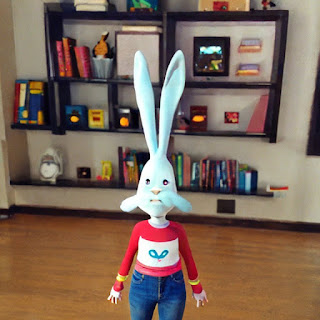Recently on Facebook, I saw a cutesy picture of a cartoon kitten carrying some flowers. It was one of those pictures that was so adorable that it transcended even its own cliched nature. So I'm sitting there thinking, aw cute widdle kitty, when something struck me as a little odd about it. The slightly soft-focus CGI looked eerily familiar...
Then I noticed it: the kitten had six toes on its paw!
What, that wasn’t a dramatic revelation for you? Oh, well, if you're not familiar with that implication, A.I.-generated art is becoming a big controversy, and - despite its leaps-and-bounds in recent years - it’s notorious for getting fingers wrong. So this picture was evidently created by one of the new graphics services that can create a picture for you based on a simple text description.
A few years ago, A.I. art programs just made weird nightmare images. But recently, they’ve been making great strides, and can now do convincing pictures of a wide variety of subjects using just about any style you can think of. But they still have their flaws, including their difficulties with hands and fingers.
That’s kind of a good thing; in the midst of the A.I.-pocalypse, this whole extra-fingers thing is kind of exciting, because it's exactly the kind of contrived plot-point they'd throw into a science-fiction story for convenience, which the fans would forever be complaining about. It's like on Star Trek, where Data couldn't use contractions.
By the way, I used to think Data’s contractions thing was pretty unbelievable, but then I learned that the laws of contractions really are quite cryptic. They’re a lot more complex than people think they’re.
I've experimented with some of the A.I. art generators, and learned some things about them. There’s Midjourney which is quite powerful, but only free for a limited number of uses, and can only be accessed on the Discord social network.
 |
| "Elephant playing basketball" by Midjourney |
Then there’s Stable Diffusion, which is free to use, though limited in its functionality. For instance, you can’t refine pictures, you can only ask it to try again. Overall, I found its first attempts were a lot better.
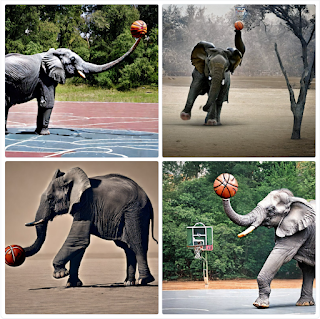 |
| "Elephant playing basketball" by Stable Diffusion |
I’d seen some amazing A.I. art on social media, so I enthusiastically tried it out. But I found out that it doesn’t always work. Here’s some of my successes (done with Stable Diffusion.)
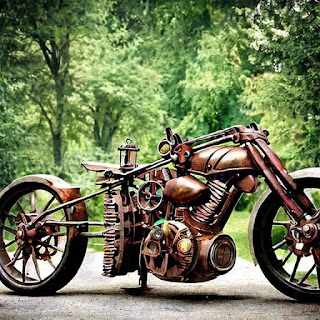 |
| "Steampunk motorcycle" |
 |
| "Chocolate hippo" |
"Humanoid nerdy bunny"
 |
| "Cow playing hockey style of Pixar" |
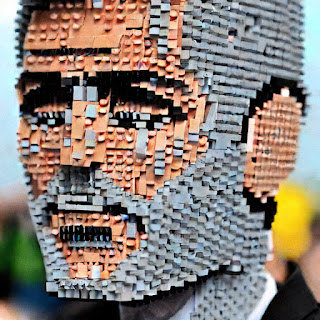 |
| "George Clooney made of lego" |
But a lot of times the results leave a lot to be desired. Here's some of what I've learned:
- They take refinement. Generally the programs work by producing several attempts. The (human) user can then choose one of those pictures to improve upon. And improving on the pictures, slowly getting closer to the desired outcome, is usually necessary. The impressive examples you see are never the first efforts. Those first attempt are usually half-formed nightmares that look like Scotty's first try working the transporter.
- On the other hand, they're great at styles. I've seen them imitate everything from Monet to Rankin-Bass Christmas specials. Even in instances where the application flubbed the content, it usually got the style right.
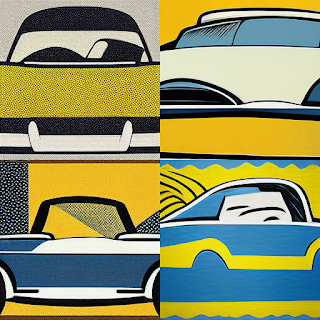 |
| "Business man driving convertible style of Roy Lichtenstein" by Midjourney. Nailed the style; content, not so much. |
Anyway, the deformed kitten was an example of how A.I. art is making its way into the mainstream, and a lot of people are unhappy. For one thing, it’s taking work from artists; though many of the A.I. art programs require a subscription, it’s still pretty cheap, and it’s easy to imagine a small firm opting for that instead of paying an artist every time they need a picture. Then there's also the use of styles. No one is really upset if ol' Monet is getting ripped off, but it can also be used to copy the style of artists and cartoonists that are working for a living today.
 |
| "Elvis style of Gorillaz" by Stable Diffusion |
The whole thing is reminiscent of NFT's. On the one hand, you have people who are enthusiastic either because it's an intriguing new technology, or because there's money to be made. So they jump on the new bandwagon. It was weird watching businesses make big announcements about getting into cryptocurrencies or NFT's, only to have howls of protest from customers. The business was then caught unprepared, because they’d spent decades working on the assumption that they had to get into new technologies as fast as possible or be left behind.
And now it's happening again with A.I. art. Worse, some of the companies that are making the mistake are in the creative industries, and thus supposed to be allies of the artists who are most wary of the new tech. Companies like Adobe and book publisher Tor have had to go into quick damage-control mode.
But there is one way this might work out well: if Big Media starts to protect its intellectual property. For instance, one of the most impressive A.I. pictures I made was "Mickey Mouse in a cafe, painted by Monet." But I’m afraid to put it on this post for fear of getting sued out of existence. That’s one thing that could stop the art-pocalypse in its tracks: some decisive court case, or a strict new law, like how the DMCA was an overreaction to MP3’s.
Interestingly, using A.I. art for memes, like that kitten, is probably the least controversial use of the technology. It’s not putting anyone out of work. And as I’ve pointed out before, Facebook memes are often hacked-together pop-culture references that completely contradict the creator’s intentions.
So for now, I find the whole thing interesting, but I'm much less enthusiastic, learning that has unpleasant imperfections and implications.




